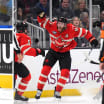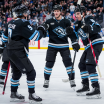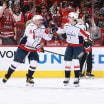If there are still questions about whether the Pittsburgh Penguins should continue to start rookie goalie Matt Murray or turn to incumbent No. 1 Marc-Andre Fleury in Game 1 of the Eastern Conference Final against the Tampa Bay Lightning at Consol Energy Center on Friday (8 p.m. ET; NBCSN, CBC, TVA Sports), Fleury's numbers against Tampa Bay during the regular season don't help his cause.
Fleury, who is healthy after missing more than a month with a concussion but hasn't played since March 31, gave up nine goals on 39 shots against the Lightning in two starts three weeks apart late in the season and was pulled after giving up four goals on 14 shots in a 6-3 loss Feb 5.
Lightning's Bishop has edge on Penguins' goalies
Positioning, puck-handling give Tampa Bay advantage

© Scott Audette/Getty Images
By
Kevin Woodley
NHL.com Independent Correspondent
Jeff Zatkoff didn't fare any better starting in place of Fleury on Feb. 20, giving up four goals on 20 shots in a 4-2 loss, but the Lightning haven't seen Murray in person, and since the 21-year-old has played 22 NHL games, there isn't a lot of film for Tampa Bay's coaches to study.
The Penguins should have plenty of footage of Tampa Bay's Ben Bishop, but it didn't help them win any of the three games against the Lightning this season, with the 6-foot-7 goalie stopping 100 of 109 shots while winning all three.
POSITIONING
Bishop will challenge beyond his crease in certain situations but was more conservative with his overall positioning this season. He gets his body to the edge of his crease when the puck is at the point but wanders farther out less frequently and will play rush chances from the goal line out, reducing extra movements that open holes in his frame.
Murray plays a similarly controlled positional game, mostly staying inside or in contact with the edge of the crease. The same can now be said of Fleury, which is the biggest difference from his past playoff meltdowns. Under goalie coach Mike Bales, Fleury established more consistent, conservative positional anchors, eliminating the overaggressive, play-chasing habits that plagued him in past playoffs.
Advantage Bishop: Murray got caught moving laterally on quick shots as the second-round series wore on against the Washington Capitals.
BLOCK/REACT THRESHOLD
Murray is at his best tracking down from an engaged stance so cut at the waist the Penguins logo disappears, but he got caught arriving late and pulling up and off shots at the end of the second round. He switched from a handshake glove position to a fingers-up approach late in the season but tracks shots, moves better to his blocker, and tends to lower his glove-side shoulder early.
Fleury has been better at reacting into shots since switching to more conservative positioning, but his old drop-and-block tendencies still show up and are dangerous against Tampa Bay's skilled shooters.
Bishop relies on reacting patiently from his skates but doesn't shift into shots as much, instead pushing to his knees, which can leave him reaching on rebounds in a way that opens up space along the ice, pulls his torso away from shots, and limits his reach with the gloves. He also relies more than some on reading shots off the stick, which led to a couple of screen goals that went through him against the Islanders. Though he may not always react in an ideal manner in terms of pulling off shots rather than moving into space, there is no denying his incredible reactions are effective, even if not always pretty.
Advantage Murray: It's hard to bet against Bishop, who is never out of a play with his long limbs and ability to react, but Murray reacts into shots more.
PUCK-HANDLING
It's not that Murray and Fleury are bad with the puck, but few NHL goaltenders handle it as well or as often as Bishop, who can neutralize a forecheck and jump-start the Tampa Bay transition.
Advantage Bishop: He does it more than and as well as anyone.
POST PLAY
If there's one change Bales made to Fleury's game that was as important as positioning, it was getting him more comfortable moving into and off of the posts. Fleury added reverse-VH, dropping his short-side pad to the ice and using his back skate as an anchor to push into the post and pivot around it, and he now moves fluidly and powerfully in and out of it. Murray also uses reverse-VH for post play and is similarly mobile without defaulting prematurely or staying down too long. But his preference for going paddle-down can leave him exposed high on the blocker side, something the Capitals turned into a bad-angle goal in Game 4 when he got caught wandering too far outside the post on T.J. Oshie's overtime wraparound in Game 1, and a lack of backside rotation cost him another key goal in Game 6.
Bishop uses reverse-VH earlier and stays in it longer, even when play is along the boards. His height allows him to seal the short-side post up to the crossbar and he can stretch his legs post to post in a butterfly stance with the puck behind the net, making wraparounds a waste of time. But those long legs also force him to lean hard into the post to get a good post seal, especially on the blocker side, which creates a slight delay in getting off that post on back-door plays. It cost him on two goals in the first round against Detroit and played a role in three Islanders goals scored against him on low-high plays.
Advantage Fleury and Murray: Size can hurt here and Bishop stays on his knees longer.
SCORING TRENDS
The book on Murray is growing and includes blocker-side shoulder exposure with his paddle down on his right post and the glove vulnerability because that shoulder dips first. Rangers forward Rick Nash exposed it on a shorthanded breakaway in the first round, Oshie beat him there in Game 1, and Alex Ovechkin scored each of his goals in the second round there. The way Murray closes on high shots also tends to create rebounds back out in front of him, and glove shots he failed to handle cleanly were costly a couple of times against Washington.
Fleury's exposures are a little more stereotypical, with more exposure on the perimeter of the net even though his drop-and-block default has diminished. He also tends to kick rebounds out with his pads more than steer them into neutral areas with his stick, and gets flat with his lateral recovery pushes after.
Bishop has done a good job of staying over his knees on scrambles, but when Detroit and New York did get him reaching they were unable to get it over those long, outstretched pads, and Bishop can turn what looks like a sure goal into a momentum-shifting save as well as any goalie in the NHL. If opponents can't get second chances into the top of the net, they are better to try along the ice because he recovers back to his skates more than most, and his reaching and tracking pull his knees off the ice when he doesn't. New York did have success with three low-high goals on quick shots to the far side in the second round, exploiting some of Bishop's post-play issues, but the big key for the Penguins may be somehow taking away his sight lines on the shot release and turning him into a blocker.
Advantage Bishop: In the regular season, Pittsburgh struggled to target specific tendencies against Tampa Bay.
















